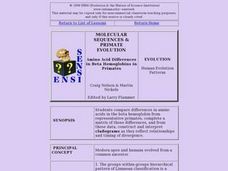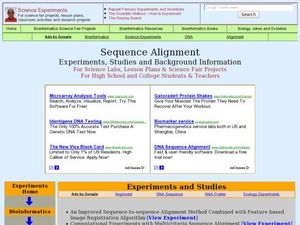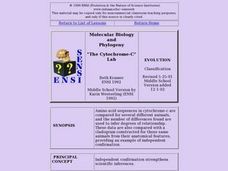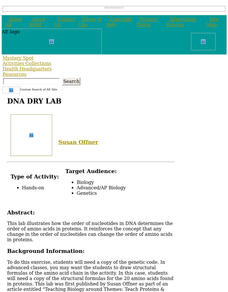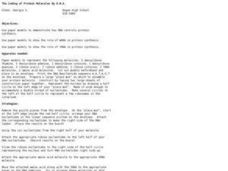Curated OER
Proteins from Plants to People
Students participate in a scientific activity to identify the building blocks for proteins (amino acids) that are needed to grow. They identify foods that contain proteins, how they are digested and rearrange the building blocks. They...
Curated OER
Transcription and Translation Lab Activity
Students investigate DNA strands. They study the sequence to determine if it is DNA or RNA and write the mRNA nucleotide sequence. After stringing the beads together to create the mRNA sequence they translate it into an amino acid...
Curated OER
Molecular Sequences & Primate Evolution: Amino Acids, Hemoglobins in Evolution
Students compare differences in amino acids in the beta hemoglobin from representative primates, complete a matrix of those differences, and from these data, construct and interpret cladograms as they reflect relationships and timing of...
Curated OER
Sequence Alignment
Young scholars explore the uses of sequence alignment. In this DNA instructional activity students complete several experiments on sequencing and algorithms.
Curated OER
DNA Replication, Transcription, and Translation
Students apply the rules of complementary base pairing to finding the complementary sequence to a given strand of DNA. After extensive researching, the also find the amino acid sequence encoded by a given strand of DNA.
Curated OER
The Cytochrome-C Lab
Young scholars examine a method biologists use to try to determine relationships. They examine how amino acid sequences have been determined for a number of proteins, and how scientists can make inferences about DNA based on the amino...
Curated OER
Sequencing the Cystic Fibrosis Gene: A Simulation
Ninth graders use this activity to simulate the sequencing of gene and to detect the presence of possible genetic defects. They use diagrams that represent bands of nucleotides in order to determine the sequence of a small piece of the...
Curated OER
DNA Dry Lab
Students use a DNA strand to identify the component parts. They discuss an RNA molecule, protein fragments, and nucleotides. They explore how the order of nucleotides determines the order of amino acids in proteins.
Curated OER
Secret Codes
Learners practice writing and decoding secret messages before discussing DNA and its role as a code for making proteins. They translate DNA into RNA and identify the sequence of amino acids to find a secret message. An interactive...
Curated OER
Discovering DNA Structure
Students work in cooperative groups of four and manipulate paper nucleotides to discover the structure of DNA. They model DNA and sing the DNA song to review concepts. Lyrics to song included in lesson plan.
Curated OER
The Coding of Protein Molecules by DNA
Students investigate the production of proteins by the DNA. In this protein synthesis lesson plan, students use paper models to explore transcription and translation to make proteins using DNA. Students answer 10 questions to demonstrate...
Curated OER
How Mutations Lead to Changes in Cell Structure and Function
Pupils investigate how mutations lead to changes in cell structure and function. They construct an oligonucleotide, identify a protein sequence, design a step-by-step mechanism of how they think cells repair damaged DNA, and prepare and...
Curated OER
Pseudogene Suite
Students use Biology Workbench to explore DNA sequence data for the GULOP gene in humans, chimpanzees, orangutans, and crab-eating macaques and the beta globin gene and its pseduogene in humans, gorillas, and chimpanzees.
Curated OER
Investigating Evolutionary Questions: Bats, Whales, Reptiles, Birds, Animal Classification
Students are guided through a process in which three questions are addressed by retrieving beta hemoglobin sequences from online databases, and using online tools to compare those sequences in student-selected animals.
Curated OER
Molecular Approaches to Evolution
Students are introduced to working with molecular data. The first activity does both simulated and original data are used to compare amino acid, protein or DNA differences to construct phylogenetic trees or cladograms. These activities...
Curated OER
Translating Genetic Information
High schoolers explore the process of translation. They determine the correct sequencing and present their strands to the class. In addition, they compare normal red blood cells to sickle cells and complete discussion questions.
Curated OER
BLAST Algorithm
Students explore a series of activities on using BLAST. In this biology lesson, students explain the significance of BLAST in DNA query. They give real world applications of BLAST.
Curated OER
Why do we need Vitamin C in our diet? Or Why do we carry old inactive genes in our genome?
Pupils explore and explain how mutations in the DNA sequence of a gene may be silent or result in phenotypic change in an organism and in its offspring. They analyze how evolution and biodiversity are the result of genetic changes that...
Curated OER
Temperature and the Tomato
You will need a photovoltaic system and monitor at your school in order to obtain all of the data required to thoroughly implement this instructional activity. Your class monitors daily temperature and insolation amounts over a two week...
Curated OER
Proteomics
Students analyze data taken from proteomic experiments. In this biology lesson, students explain the importance of bioinformatics tools in the study of proteins. They evaluate scientific results using math and computer software.
Curated OER
Construction of a Hemoglobin Gene
Learners see how eight pairs of triplets are equivalent to part of a gene and control a part of heredity. They comprehend how blood corpuscles manufacture normal hemoglobin. Students already comprehend that genes control the synthesis...
Curated OER
Molecular Approaches to Evolution
High schoolers examine the molecular studies of organisms that have led to a new era in their understanding of speciation and evolutionary relationships. Students study the allelic frequency of genes controlling specific molecules and...
Curated OER
Structural Changes in a Protein
Students observe and manipulate the structure of a protein. They form an alpha helix, a beta sheet, and add disulfide bonds. They create a multimeric protein and compare their location with other students.
Curated OER
Molecular Structure of Proteins
Students examine the effects different substances have on proteins. They test different molecules reaction to water. They discover how the amount of water affects the shape of the protein.




